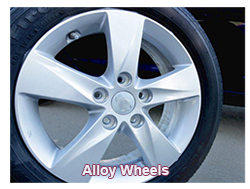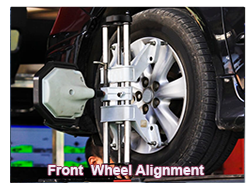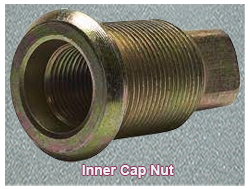
ALIGN: Describes the process of adjusting a car's wheels and other devices so that they are in a straight line.
ALIGNMENT: Describes a procedure relating especially to wheel alignment, where a vehicle's front or rear suspension is checked to ascertain if its camber, toe-in, toe-out, kingpin inclination or steering axis inclination requires alignment as well as its turning radius ride height. Four-wheel drive vehicles will require alignment on all four wheels.
Describes a procedure relating especially to wheel alignment, where a vehicle's front or rear suspension is checked to ascertain if its camber, toe-in, toe-out, kingpin inclination or steering axis inclination requires alignment as well as its turning radius ride height. Four-wheel drive vehicles will require alignment on all four wheels.
ALLOY WHEEL: Describes any non-steel road wheel usually cast in one piece containing aluminium or magnesium. The latter ingredient leads to this type of wheel being titled "mag wheel".
ASPECT RATIO: Describes the distance relationship in a wheel from the wheel rim to the tire's width.
BALANCE WEIGHT: Describes a situation where a lead weight is attached to the rim of a wheel to improve its balance.
BRIDGE: Describes the metal support installed in the valve slot of a wheel rim that prevents the flap and tube from bulging through the slot under high pressure and high heat conditions.
BURRED WHEEL: Describes a car wheel with metal slivers or roughness around the edge of the rim.
CAMBER: Describes a wheel alignment adjustment of the inward or outward tilt on the top of the wheel when viewed from the vehicle's front.
CAST SPOKE TYPE: Describes a method of dual mounting wheels where two demountable rims are mounted directly on the spoke wheel and drum assembly and held apart by a spacer band, locked in place by clamps and nuts.
CROSS-SPOKE WHEEL: Describes a modern design of alloy wheel that imitates the appearance of the classical wire wheel
CROSS THREE: Describes a spoking pattern in which a spoke passes over two and under a third spoke before being attached to the rim.
DISC WHEEL: Describes a rim and metal disc that have been welded together, with the disc offset from the centreline of the rim to allow for dual tire mounting and provide sufficient clearance between the duals. Disc wheels are attached to the hub with either single nuts or double cap nuts.
DISC WHEEL TYPE: Describes a type of dual mounting wheels where the discs are offset from the centreline of the rim to provide clearance between the tires held in place by double cap nuts, inner cap nuts, and outer cap nuts.
DOUBLE CAP NUT: Describes a securing device consisting of an inner cap nut (sleeve nut) and an outer cap nut that is the most common method for mounting disc wheels
DUST CAP: Describes a metal or plastic covering that fits into a hub shell to keep contaminants out of hub bearings.
FLAT HUMP: Describes a raised and flattened portion on the bead seat of some wheel rims, which retain the beads of an insufficiently inflated tire on the bead seat, thereby preventing the tire beads from jumping into the rim well.
FRONT-END ALIGNMENT: Describes the adjustment of the camber and caster of the front wheels.
HUMP: Describes a raised portion on the rim bead seat of passenger car wheels that retains the beads of an insufficiently inflated tubeless tire on the bead seats, thus preventing the tire beads from jumping into the rim well.
IMBALANCE:  Describes a lack of balance in road holding due to improper wheel balance on the tire and wheel assembly, which can cause severe vibration.
Describes a lack of balance in road holding due to improper wheel balance on the tire and wheel assembly, which can cause severe vibration.
INNER CAP NUT: Describes a dual-mounted disc wheel type that is threaded directly on the stud and holds the inner wheel in place against the hub.
UB5


